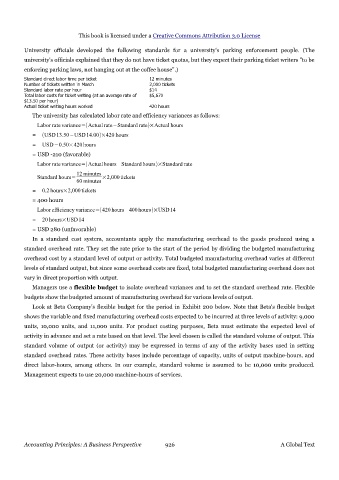Page 925 - Accounting Principles (A Business Perspective)
P. 925
This book is licensed under a Creative Commons Attribution 3.0 License
University officials developed the following standards for a university's parking enforcement people. (The
university's officials explained that they do not have ticket quotas, but they expect their parking ticket writers "to be
enforcing parking laws, not hanging out at the coffee house".)
Standard direct labor time per ticket 12 minutes
Number of tickets written in March 2,000 tickets
Standard labor rate per hour $14
Total labor costs for ticket writing (at an average rate of $5,670
$13.50 per hour)
Actual ticket writing hours worked 420 hours
The university has calculated labor rate and efficiency variances as follows:
Labor ratevariance=Actualrate – Standard rate×Actual hours
= USD13.50 – USD14.00×420 hours
= USD−0.50×420 hours
= USD -210 (favorable)
Labor ratevariance=Actualhours – Standard hours×Standard rate
12 minutes
Standard hours= ×2,000tickets
60 minutes
= 0.2 hours×2,000tickets
= 400 hours
Labor efficiency variance=420 hours – 400 hours×USD14
= 20 hours×USD14
= USD 280 (unfavorable)
In a standard cost system, accountants apply the manufacturing overhead to the goods produced using a
standard overhead rate. They set the rate prior to the start of the period by dividing the budgeted manufacturing
overhead cost by a standard level of output or activity. Total budgeted manufacturing overhead varies at different
levels of standard output, but since some overhead costs are fixed, total budgeted manufacturing overhead does not
vary in direct proportion with output.
Managers use a flexible budget to isolate overhead variances and to set the standard overhead rate. Flexible
budgets show the budgeted amount of manufacturing overhead for various levels of output.
Look at Beta Company's flexible budget for the period in Exhibit 200 below. Note that Beta's flexible budget
shows the variable and fixed manufacturing overhead costs expected to be incurred at three levels of activity: 9,000
units, 10,000 units, and 11,000 units. For product costing purposes, Beta must estimate the expected level of
activity in advance and set a rate based on that level. The level chosen is called the standard volume of output. This
standard volume of output (or activity) may be expressed in terms of any of the activity bases used in setting
standard overhead rates. These activity bases include percentage of capacity, units of output machine-hours, and
direct labor-hours, among others. In our example, standard volume is assumed to be 10,000 units produced.
Management expects to use 20,000 machine-hours of services.
Accounting Principles: A Business Perspective 926 A Global Text

